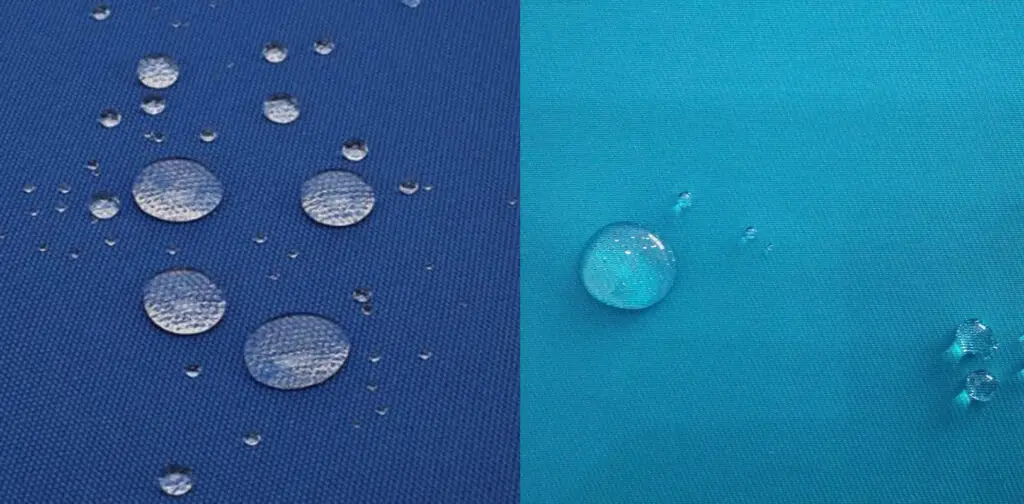Nylon and polyester are two most widely produced fabrics in the world, and they share many similar characteristics.
They’re both lightweight, synthetic fiber-based materials and also popular choices for outdoor and sportswear. This is due to their superior durability compared to natural fibres.
However, there is a distinction between polyester and nylon fabrics. Understanding how their properties differ can assist you in determining which material is most suited for the apparel you’re producing.
While both fabrics are not waterproof, however, they do have water repelling properties. Polyester resists water better than nylon does. It has a moisture regain level of 0.4%, compared to nylon’s moisture regain level of 4%. To put it another way, polyester is more hydrophobic than nylon.

Waterproof Vs Water-resistance
A fabric must be able to keep water on its surface without any moisture leaking through to be considered genuinely waterproof.
Most materials are not completely waterproof in their natural form. To make them completely waterproof, they are frequently coated with a specific coating.
Water is repelled from the surface of water-resistant fabric. However, if enough pressure or weight is applied to the cloth, the moisture will eventually seep through.
Let us have a better understanding of both the materials:
Nylon- Nylon is a class of synthetic polymers generated from petroleum known as thermoplastics. It is a very robust material considered even stronger than polyester. It is the second most widely used fabric in the world after cotton.
Also, being a fabric by nature, it may also be made into hard yet flexible material that can be utilised for mechanical components, gears, hair combs, and other products. When nylon stretches, the fibres become thin and smooth while remaining strong.
Polyester- Polyester is the name given to a class of synthetic chemicals that may be weaved or spun into fabric. Polyethylene terephthalate (PET) is the most prevalent kind of polyester used in fabrics.
PET is also used to make a variety of plastic bottles. Polyester is now utilised to make a wide range of items including fabrics, belts, furniture, cushioning and glossy hardwood top coat.
Let’s look at some of the advantages and disadvantages of both materials:
Advantages of Nylon
1.) Highly stretchable because of good elasticity.
2.) Resistant against mold and fungus.
3.) Stain-resistant.
4.) Simple to clean.
5.) Long-lasting and abrasion-resistant.
6.) Strong and resilient in nature.
7.) Water repelling.
Disadvantages of Nylon
1.) Tends to fade in direct sunlight.
2.) Non-recyclable and hazardous to the environment.
3.) Static electricity may be generated.
Advantages of Polyester
1.) Extremely tough and abrasion-resistant.
2.) Resistant against mold and mildew.
3.) Doesn’t fade easily.
4.) It is simple to clean.
5.) Water-resistant and quick-drying.
6.) Resistant to stretching and shrinking.
7.) Recyclable.
Disadvantages of Polyester
1.) Non porous, therefore not breathable.
2.) Prone to oil-staining.
So what are the main differences between the two fabrics?
1.) In terms of durability
Both fabrics score well in terms of strength and durability. However, nylon is stronger and stretchier than polyester, implying that nylon clothes should last longer.
When it comes to abrasion resistance, polyester beats nylon in this category. Though it is more water resistant than polyester, nylon is more prone to pilling.
While this does not damage the garment, it does impact the overall appearance of the fabric.
See also: Is Polyester Good for Gloves?
2.) Features of the fabric
Nylon and polyester are both abrasion resistant and resistant to most chemical degradation. Nylon is also grease and oil resistant.
Both are combustible fabrics, but nylon melts and burns quickly. Polyester has a greater fire resistance but it also melts and burns simultaneously.
Both fabrics are also wrinkle-resistant, with polyester having more resistance to wrinkling than nylon. It is a crisp, robust fabric that does not stretch or shrink when wet or dry.
Both nylon and polyester have a low moisture absorption, although nylon is relatively lower than polyester.
See also: Is Nylon Good for Gloves?
3.) Talking about comfort
Both nylon and polyester are lightweight fabrics that are also quick-drying, and smooth in terms of comfort.
Nylon is often warmer than polyester and might be more sweaty or is more prone to stick to the body. Polyester fabric has moisture-wicking abilities.
4.) How each fabric reacts to water
When nylon absorbs water, it expands by up to 3.5%. As a result, whether you’re sweating or doing your job out in the rain, your nylon fabric will take longer to dry if they get wet.
Polyester, on the other hand, is far less absorbent. It’s a hydrophobic fabric, which means water is pushed to the garment’s surface, making it easier to evaporate.
This makes polyester ideal for great physical activities that are sure to produce more sweat. high intensity activities that need a lot of sweat.
See also: Are 100% Polyester Jackets Warm?
5.) Care and maintenance
Both materials are relatively simple to maintain. They are neither wrinkled, stretched, or shrunk easily. Both nylon and polyester are resistant to mold, mildew, and staining.
A simple wash in the machine is sufficient to clean the fabrics. They need not be dry washed. Also, avoid ironing and drying the fabrics on tumble. Even if you do so, always consider the lowest heat possible.
Also avoid using fabric conditioner while washing nylon and polyester, especially if they are moisture wicking apparels.
Now since we know polyester repels moisture and water more than nylon, but it is still not completely waterproof.
So how can you make your polyester fabric 100% waterproof?
The most common ways to make polyester completely waterproof include tightening the weave of the polyester fabric and applying a seal or coating to the cloth. Let us see below on how it’s done.
1.) More thread count
I’m pretty sure you’ve heard of thread counts from things like bed sheets and blankets. And you’re probably aware that any sheet that contains more thread count is exceptionally soft and silky, but sheets with little thread counts may be a little coarser to the touch.
Polyester operates in a similar manner, however its fabric thread count is measured in a unit known as a denier. A high denier usually indicates a thicker or more closely woven cloth.
More strands woven closer together implies less air holes in the weave for water to enter. As a result, a higher denier polyester fabric will be more resistant to water than a lower denier fabric.
2.) Top coat
The most efficient approach to totally waterproofing your polyester fabric is to apply a protective seal or coating to it.
You can go for Scotchgard Sun and Water Shield spray here-
- Helps protect fabric from fading by blocking out harmful UVA/UVB rays
- Delivers excellent water repellency to outdoor fabrics, leather and suede. Not intended for indoor use
- Simple one-step application that dries odorless and resists yellowing
Prices pulled from the Amazon Product Advertising API on:
Product prices and availability are accurate as of the date/time indicated and are subject to change. Any price and availability information displayed on [relevant Amazon Site(s), as applicable] at the time of purchase will apply to the purchase of this product.
It is one of the most widely used and efficient spray coatings. It may be lightly sprayed over a variety of surfaces (even polyester) to provide a layer of protection against UV radiation, water, and dust. It is also odorless and aids in the prevention of yellowing.
Some FAQs-
Is polyester ideal for rain?
Polyester resists water. It is mostly considered to be used in the manufacture of raincoats and winter jackets.
Polyester is made to be strong and long-lasting and the fabric is also wind, stain and mold resistant. Apart from that, it is also tear-resistant due to its strong plastic threads.
The moisture-resistant surface of polyester allows you to easily wipe any mud or stains off its surface without causing any damage to the fabric. In short, polyester is an ideal fabric for rain.
Is nylon ideal for rain?
Nylon apparels can be worn on rainy days if it has been treated with a waterproof solution. Many other fabrics, like polyester, are more hydrophobic than nylon, making them a better choice when it’s raining.
Conclusion
While we know that both nylon and polyester are water-resistant, polyester still repels water better than nylon does. But both fabrics can be used in rain if they are coated with waterproof sprays to make them 100% waterproof.
It is important to know the uses of both the fabrics along with its pros and cons so that you can properly choose your fabric according to the occasion.








